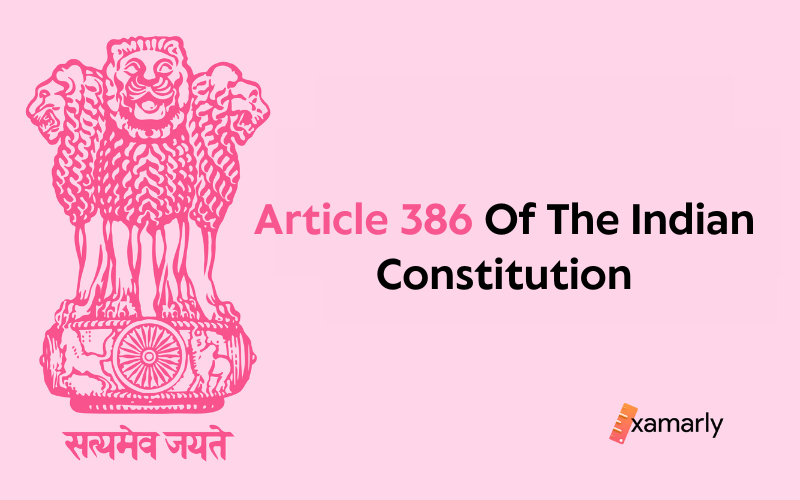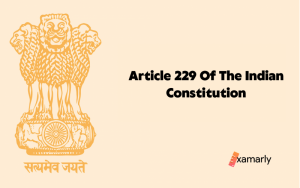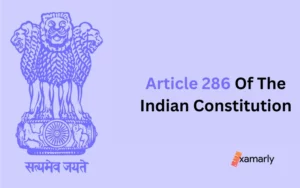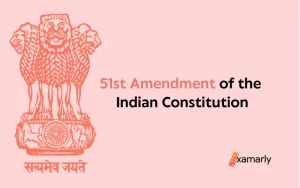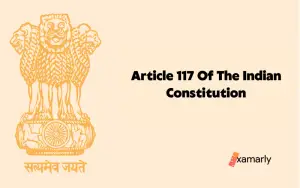Article 386 of the Indian Constitution mentions about the Council of Ministers for States in Part B of the First Schedule.
In this article, we’ll explore in depth about Article 386 of the Indian Constitution, it’s provisions & omission from the Constitution of India.
- Article 386 Of The Indian Constitution – In Depth
- Article 386 Of The Indian Constitution – Omission
- Summary
- FAQs Around Article 386 Of The Indian Constitution
- What was the purpose of the Council of Ministers for States in Part B of the First Schedule?
- Who appointed the Council of Ministers for States in Part B of the First Schedule?
- Who had the power to dismiss the Council of Ministers or any individual minister?
- Were the Council of Ministers responsible to the Legislative Assembly of the state?
- When did the provision for Council of Ministers for States in Part B of the First Schedule end?
Article 386 Of The Indian Constitution – In Depth
Article 386 of the Indian Constitution relates to the power of the President to merge a Union Territory with an adjacent state.
It provides that the President may by order provide for the merger of a Union Territory with an adjacent state, and for the alteration of the Constitution in its application to the merged territory, and for all other matters connected with such merger.
The President’s order under this article is subject to the approval of the Parliament.
The Article 386 was added to provide a legal framework for the merger of Union Territories with adjacent states.
It was used to merge the Union Territory of Dadra and Nagar Haveli with the state of Gujarat and Union Territory of Pondicherry with the state of Tamil Nadu.
The First Schedule of the Indian Constitution contains the territories of the states and union territories of India, and it is divided into two parts: Part A and Part B.
Part A states were the former British Indian Provinces, and Part B states were the former princely states.
The provision for Council of Ministers for States in Part B of the First Schedule is that, the Rajpramukh (Governor) of each Part B state was to appoint a Council of Ministers to aid and advise him in the exercise of his functions.
The Rajpramukh (Governor) had the power to dismiss the Council of Ministers or any individual minister.
The Council of Ministers was to be responsible to the Legislative Assembly of the state, and if the Assembly passed a vote of no confidence in the Council, the Rajpramukh (Governor) was required to either dismiss the Council or dissolve the Assembly.
This provision for Council of Ministers for States in Part B of the First Schedule was in effect until the merger of princely states with the Indian Union and the abolition of the office of Rajpramukh (Governor) by the 7th Amendment Act of 1956.
The 42nd Amendment Act of 1976 abolished the office of Rajpramukh and made the governor of a state to be a nominal head and the real executive power was vested in the council of ministers.
Article 386 Of The Indian Constitution – Omission
Article 386 of the Indian Constitution was omitted from the Constitution of India by the Constitution (Seventh Amendment) Act, 1956.
Summary
The Council of Ministers for States in Part B of the First Schedule was a provision in the Indian Constitution that applied to the former princely states that were listed in Part B of the First Schedule of the Constitution.
With the gradual dissolution of princely states, the need for the provisions under Article 386 of the Indian Constitution were not necessarily needed, hence the repeal.
You Might Also Like To Read: Article 384 Of The Indian Constitution.
FAQs Around Article 386 Of The Indian Constitution
What was the purpose of the Council of Ministers for States in Part B of the First Schedule?
The Council of Ministers for States in Part B of the First Schedule was a provision in the Indian Constitution that applied to the former princely states that were listed in Part B of the First Schedule of the Constitution.
The purpose of the Council of Ministers was to aid and advise the Rajpramukh (Governor) of each Part B state in the exercise of his functions.
Who appointed the Council of Ministers for States in Part B of the First Schedule?
The Rajpramukh (Governor) of each Part B state was responsible for appointing the Council of Ministers
Who had the power to dismiss the Council of Ministers or any individual minister?
The Rajpramukh (Governor) had the power to dismiss the Council of Ministers or any individual minister.
Were the Council of Ministers responsible to the Legislative Assembly of the state?
Yes, the Council of Ministers were responsible to the Legislative Assembly of the state.
When did the provision for Council of Ministers for States in Part B of the First Schedule end?
The provision for Council of Ministers for States in Part B of the First Schedule ended after the merger of princely states with the Indian Union and the abolition of the office of Rajpramukh by the 7th Amendment Act of 1956.
The 42nd Amendment Act of 1976 abolished the office of Rajpramukh and made the governor of a state to be a nominal head and the real executive power was vested in the council of ministers.


